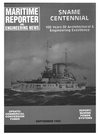
Page 67: of Maritime Reporter Magazine (September 1993)
Read this page in Pdf, Flash or Html5 edition of September 1993 Maritime Reporter Magazine
CENTENNIAL 1893-1993 100 Years
Of
Innovation
The contributions made by the
Society of Naval Architects and Ma- rine Engineers (SNAME) to the maritime industry have been con- siderable, to say the least. Since
Charles H. Cramp delivered the keynote address at the initial
SNAME meeting in 1893, the an- nual conference has been a thor- oughfare used by many of the industry's pioneering personalities to deliver groundbreakingideas. The following is a limited review of some of the more outstanding contribu- tions SNAME members have made to the industry. (NOTE: Mr. Wil- liam duBarry Thomas, a naval architect whose great grandfather was a charter member of SNAME, was instrumental in gathering the information that follows. For the
SNAME Centennial, Mr. Thomas has put together a book entitled "Speed on the Ship" for SNAME, which reviews the association's first 100 years.) • Refueling: Spencer Miller, of
Lidgerwood Manufacturing, wrote a series of papers on "Coaling At
Sea." In total, he wrote six papers between 1899 and 1914, and many of the principles which were put forth in those papers served as the basis for the way fuel is replenished at sea today. •Vibration Control: Frank Lewis, a professor at M.I.T., is the acknowl- edged expert on vibration, and wrote five papers on the topic up to 1943, including his 1925 paper entitled "Torsional Vibration and the Diesel
Engine." Prior to his work, vibra- tion was a "black magic" situation, according to Mr. Thomas, and the papers he contributed were the foun- dation of vibration knowledge as we know it today. • Safety At Sea: This area is argu- ably one of the most important in which SNAME members' contribu- tions have been noted. In 1934 when fire ravaged the passenger ship
Morro Castle—a watershed event for ship safety—the Congress ap- pointed a special committee to rec- ommend shipbuilding changes for fire protection. Rear Adm. George
H. Rock, president of SNAME from 1934 to 1936, chaired the special committee which submitted recom- mendations which are the basis for modern fire prevention and U.S.
Coast Guard rules, said Mr. Tho- mas. Another SNAME member,
George G. Sharp, coincidentally had written "Fire Control for Pas- senger Vessels" in 1933, before the
Morro Castle incident. Mr. Sharp offered an updated version of the same title on safety at sea in 1937. • Propeller Design: In the early days, the only basis for comparison of propellers was the performance of the last one built. According to Mr.
Thomas, the real turning point in propeller design came in the 1925 when theoretical propeller design, according to hydrodynamic theory, was discussed in detail at the an- nual meeting, sparked by a paper entitled "The simple method of de- signing propellers."
Perhaps, though, the biggest breakthroughs in propeller design came with, and closely followed, the development of computers. • Probabilistic Theory: There have been quite a few important papers given recently which apply probabi- listic theory to the design of ship structure, survivability in collision or grounding, and most recently, the double hull tanker debate. Citing a paper which caused "spirited dis- cussion," Mr. Thomas points to a presentation by Jeremy Hook in 1991, which addressed the OPA 90/ double hull tanker controversy from a probabilistic standpoint, and con- cluded that the so-called mid-deck design, under certain circumstances, might be a better alternative.
Circle 189 on Reader Service Card
September, 1993 69

 66
66

 68
68
